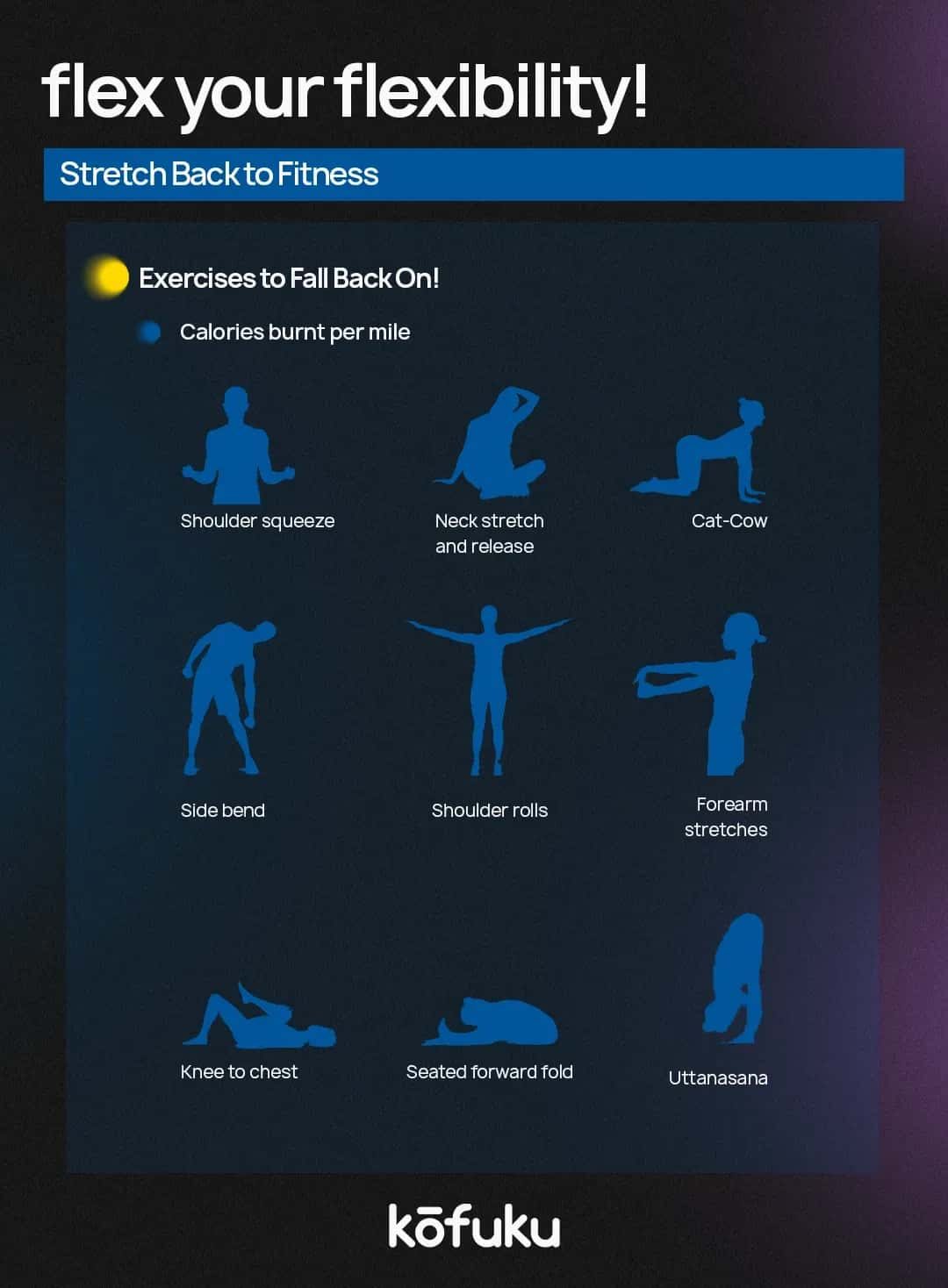The Unknown Link Of Fitness Flexibility And Longevity

Introduction
We have a quick exercise for you. Ask the people around you what the key is to a long healthy life. You’ll get the usual answers like eating healthy, doing cardio, mindfulness, spending time outside, walking, and going to the gym. However, something that often goes under the radar is flexibility.
Many people don’t realise how flexibility affects longevity. While strength training and cardio are widely recognised for their role in keeping us fit and healthy, the benefits of flexibility for longevity are just as significant, if not more, but it’s just not talked about enough.
What is Flexibility?
To keep it simple, flexibility is the ability to move and stretch your joints and muscles through their full range of motion. It impacts your mobility, posture, balance, and overall movement. Research suggests that flexibility training for seniors and younger people can significantly extend lifespans and improve quality of life.
So, let’s look at how flexibility affects longevity, the role of stretching in longevity, the importance of fitness for longevity, and what you can do to improve your flexibility!
How Flexibility Affects Longevity
The link between fitness, flexibility, and longevity is rooted in mobility and movement efficiency. As people age, their muscles and joints naturally stiffen, leading to a lesser range of motion, increased risk of injuries, and difficulties performing everyday tasks.
Think of it like a rubber band. When you use one regularly, it stretches pretty well and you can use it to close your chip packet really easily. Now pick one that’s just been lying in your house for years and it snaps the moment you stretch it. That’s how joints and muscles work as you get older.
According to research, good flexibility, especially among older people, helps with balance, prevents falls, and ensures independence. In fact, longevity and mobility exercises can contribute to better heart health, reduced inflammation, and even improved cognitive function.
A study published in the American Physiological Society journal found that people with better flexibility and arterial health had lower risks of cardiovascular disease. Since flexibility is closely tied to circulation and muscular function, it directly impacts long-term health.
The Science Behind Flexibility and Healthspan
Healthspan refers to the number of years a person lives in good health, free from serious diseases or mobility restrictions. Studies in longevity exercise science have shown that maintaining flexibility through stretching and mobility exercises can:
-
Improve circulation, allowing better oxygen and nutrient delivery to muscles and tissues.
-
Reduce chronic pain by alleviating muscle tightness and joint stiffness.
-
Lower stress and cortisol levels, which contribute to premature aging.
-
Enhance posture and balance, preventing falls and injuries that can significantly reduce life expectancy in older adults.
Thus, fitness's impact on longevity isn't just about muscle strength and endurance but rather flexibility, which plays such an underrated role in keeping the body functional and mobile for a longer time. No wonder yogis and sages look so young in historic paintings!

The Longevity Benefits of Flexibility Training
Injury Prevention and Joint Health
One of the main benefits of yoga and stretching is its ability to prevent injuries. When muscles and joints are tight and stiff, they are more prone to strains, sprains, and tears. However, flexibility training helps keep these connective tissues supple, reducing wear and tear on the body.
For example, stretching exercises improve the elasticity of tendons and ligaments, reducing the risk of fractures and muscle tears, which become common problems as people age.
Reduced Risk of Falls and Better Balance
Falls are one of the leading causes of injury-related deaths among older people. And when they aren’t very flexible, it contributes to poor posture, balance issues, and impaired coordination, all of which increase fall risks.
Flexibility and mobility exercises strengthen our stabilising muscles, improve proprioception (body awareness), and reaction time, reducing the likelihood of falls. Yoga is excellent for improving balance and flexibility.
Improved Blood Circulation and Cardiovascular Health
Studies have shown that flexibility increases lifespan by improving blood circulation. When muscles and tissues remain flexible, blood flows more efficiently, so the heart doesn’t have to pump as hard. Stiff muscles, on the other hand, can restrict circulation and contribute to increased blood pressure.
A study in The Journal of Aging and Physical Activity found that older adults who practiced regular stretching routines had better arterial flexibility, reducing their risk of heart-related conditions.
Better Posture and Spinal Health
Poor posture is a big contributor to chronic pain, spinal misalignment, and even breathing difficulties. Flexibility training plays such an underrated role in maintaining proper posture by keeping the spine, hips, and shoulders mobile and aligned.
Posture problems can lead to muscular imbalances, joint degeneration, and even digestive issues. Stretching exercises for a longer life, particularly those focusing on the spine and core, help maintain an upright posture, reducing the risk of developing mobility limitations as you age.
Stress Reduction and Mental Well-Being
Just like the gym is therapy for many people, yoga and stretching can help with our mental health. Stretching, yoga, and deep breathing exercises are known to reduce stress and lower cortisol levels, both of which are associated with premature aging.
When we stretch, our nervous system shifts into a state of relaxation, promoting better sleep, reduced anxiety, and improved cognitive function. Mental clarity and emotional balance are crucial in how fitness extends lifespan, making flexibility training an essential component of longevity-focused wellness.
Best Flexibility Exercises for Longevity
Adding flexibility exercises for longevity into your daily routine doesn't need to block hours together. Just 10-15 minutes a day can go a long way! Here are some exercises that are easy to get you going.
1. Dynamic Stretching (Before Workouts)
Leg Swings – Improves hip mobility and balance.
Arm Circles – Enhances shoulder flexibility.
Torso Twists – Increases spinal mobility.
2. Static Stretching (Post-Workout or Before Bed)
Hamstring Stretch – Keeps leg muscles supple and reduces lower back pain.
Quadriceps Stretch – Prevents knee injuries and strengthens mobility.
Hip Flexor Stretch – Reduces stiffness in the lower body, improving posture.
3. Yoga Poses for Longevity
Downward Dog – Enhances full-body flexibility and circulation.
Cobra Pose – Strengthens the lower back and improves spinal health.
Seated Forward Bend – Increases hamstring flexibility and improves digestion.
4. Mobility Drills for Longevity and Healthspan
Ankle Circles – Enhances foot mobility and balance.
Shoulder Rolls – Relieves tension in the upper body.
Cat-Cow Stretch – Promotes spinal flexibility and reduces stiffness.

How to Incorporate Flexibility Training Into Your Lifestyle
Make Stretching a Daily Habit
It’s easy to do it, but it's hard to do it every day. Consistency is key whether it's morning stretches, yoga before bed, or mobility drills at work.
Combine Flexibility With Strength and Cardio
For the best results, longevity and exercise routines should include a balance of strength, cardio, and flexibility, which only take up a few minutes of your daily life.
Stay Hydrated and Eat a Balanced Diet
Muscles and joints function best when they are properly hydrated and nourished with essential nutrients like omega-3s, collagen, and vitamin D. A healthy diet and supplements if needed can go a long way!
Listen to Your Body
Flexibility training should feel good but it’s the kind of hard work that feels good. Work within your range of motion and gradually improve over time
Conclusion
We might go to the gym regularly, lift the water can to the dispenser, and even go to therapy! But flexibility is something that deserves the spotlight too. Maybe even more than other physical exercises. The longevity benefits of yoga, stretching, and mobility drills go beyond physical fitness as they contribute to better mental health, stress relief, and long-term vitality.
So, if you're looking to increase your lifespan, start prioritising flexibility training today. Your future self will thank you!


Fitness for Older Adults - Mobility and Flexibility

Cristiano Ronaldo Is Defying Age: How Can We Learn From It?

More Than Pills – Beat Lifestyle Diseases Naturally


